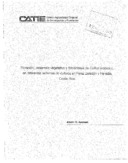Floración, desarrollo vegetativo y fotosíntesis de Coffea arabica en diferentes sistemas de cultivos en Pérez Zeledón y Heredia, Costa Rica
Alternative title
Flowering, vegetative growth and photosynthesis of Coffea arabica L. in different culture systems in Pérez Zeledón y Heredia, Costa Rica
Description
Tesis (Mag.Sc.) -- CATIE, Turrialba (Costa Rica), 2002 56 páginas 7 ilustraciones. 20 tablas Referencias en las páginas 48-53
Abstract
El objetivo principal de esta investigación fue de contribuir a un mejor entendimiento del comportamiento vegetativo y reproductivo del café en estos SAF en comparación a su cultivo en Pleno Sol. El desarrollo vegetativo del café fue mayor bajo los SAF comparando con pleno sol. Dentro de estos sistemas, los mejores resultados agronómicos para el cultivo de café se observaron bajo Terminalia seguido por Eucalipto debido a mejores condiciones micro climáticos y más específicamente una disminución de la RAFA disponible (55-70 por ciento) en comparación con el poró y el pleno sol. La floración se adelantó en pleno sol e igualmente en las bandolas más expuestas a la RAFA en los SAF. No hubo una tendencia bien definida del efecto de la distancia del cafeto respecto al árbol sobre el desarrollo vegetativo, la floración y la fructificación del café en los SAF. En la segunda parte de la presente investigación, los efectos de la carga y del aislamiento (descortezada) de la bandola sobre el crecimiento vegetativo, la fructificación, la fotosíntesis de hojas y frutos de café en pleno sol fueron evaluados en el Centro de Investigación del Instituto de Café de Costa Rica (CICAFE) en Barva de Heredia, Costa Rica. El objetivo principal fue de investigar como los tratamientos principales (carga fructífera y aislamiento de bandola) influyen sobre el desarrollo vegetativo, la fotosíntesis de hojas y de frutos. Además, el segundo objetivo fue de evaluar la contribución de los frutos a su propio suministro en carbohidratos. The main objective of this research was to contribute to a better understanding of the vegetative and reproductive behaviors of Coffea arabica in these different systeMON. Vegetative growth was superior in the AF systeMON than in full sun. The best performance was under Terminalia followed by Eucalyptus because of a better microclimatic buffering and specially a lower photosynthetic active radiation (55 to 70 percent of full sun, respectively). Flower number by productive nod was superior in full sun in comparison to the three AF systeMON. Distance to the shade tree had no significant effect regarding with vegetative growth, flower and fruit number by productive nod, and fruit weight. In the second part of the present investigation, the effects of coffee fruit load and branch ringbarking were evaluated on CICAFE research farm, in Barva de Heredia, Costa Rica. The main objective of this research was to evaluate how the main treatments (coffee fruit load and ringbarking) influenced vegetative growth as well as leaf and fruit photosynthesis. Moreover, a second objective was to evaluate the contribution of fruit assimilation to its own carbohydrate demand.
Keywords
Asesor
Vaast, Philipphe
Publisher
CATIE, Turrialba (Costa Rica)
URI (Permanet link to cite or share this item)
https://repositorio.catie.ac.cr/handle/11554/5147Collections
- Tesis [1392]


